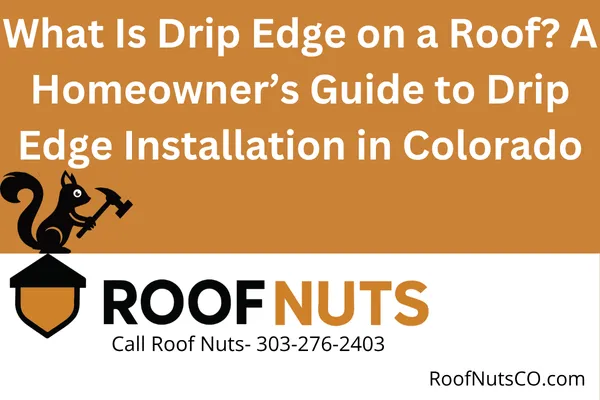
What Is Drip Edge on a Roof? A Homeowner’s Guide to Drip Edge Installation in Colorado
What Is Drip Edge and Why Does Your Roof Need It?
Drip edge is a metal flashing installed along the edges of your roof to direct water into your gutters and away from your fascia and soffit. Without it, water can seep underneath your shingles and cause rot, mold, and structural damage.
In Colorado, where homes face snow, hail, and freeze-thaw cycles, drip edge isn’t just a nice-to-have—it’s a must. The International Residential Code (IRC) now requires it for all new residential roofing systems .
Where Is Drip Edge Installed?
Drip edge is installed in three key areas:
Eaves (lower roof edges): The drip edge goes under the roofing underlayment to direct runoff into the gutter.
Rakes (sloped edges): Here, it’s installed on top of the underlayment to block wind-driven rain.
Fascia boards: Some contractors extend the drip edge slightly over the fascia to improve drainage.
Correct placement ensures your shingles, underlayment, and decking stay dry and protected.
How Is Drip Edge Installed?
Drip edge is usually made of aluminum or galvanized steel, shaped in an "L" or "T" profile with a small kickout at the bottom to push water away.
Here’s the basic process:
Measure and cut the metal strips to fit your eaves and rakes.
Install at the eaves first, underneath the underlayment, fastening with roofing nails.
Install at the rakes, this time over the underlayment.
Lap each piece by at least 2 inches to maintain waterproofing.
Seal corners and overlaps with roof cement or tape where needed.
For metal roofs, ensure the drip edge accommodates thermal expansion and contraction, especially in Colorado’s freeze/thaw cycles.
Common Mistakes to Avoid
Skipping the eave installation: This can lead to water getting under your shingles and damaging the sheathing.
Improper overlap: A poor lap can let wind-driven rain in and cause leaks.
Not using high-temp membrane at eaves: This is especially important in ice-dam-prone areas like Denver or Colorado Springs.
Is Drip Edge Required by Code?
Yes. Under the 2021 IRC (R905.2.8.5), drip edge must be installed at both eaves and rakes for asphalt shingle roofs . Local Colorado municipalities enforce this, especially due to our harsh weather conditions.
FAQ: Drip Edge Roofing in Colorado
Do I need drip edge if I have gutters?
Yes. Gutters manage where the water goes, but drip edge protects the roof edge from water seeping behind the gutter.
Can I install drip edge on an existing roof?
Yes, but it’s harder. The shingles may need to be lifted or replaced. It’s easier and cheaper to install during a full roof replacement.
How much does drip edge installation cost?
It’s often included in a roof replacement. If done separately, it typically costs $2 to $4 per linear foot installed.
What’s the best drip edge for metal roofs?
Use a high-back “T-style” or extended L-flashing compatible with the panel system. Confirm with the roof panel manufacturer for thermal movement specs.
Schedule a Roof Inspection or Drip Edge Repair
If you’re in Denver, Fort Collins, Colorado Springs, or surrounding areas, contact Roof Nuts Colorado for expert drip edge installation. Our team ensures your roof is built to code, protected from the elements, and ready for anything the Front Range can throw at it.
📞 Call us at 303-276-2403
🔗 https://RoofNutsCO.com
